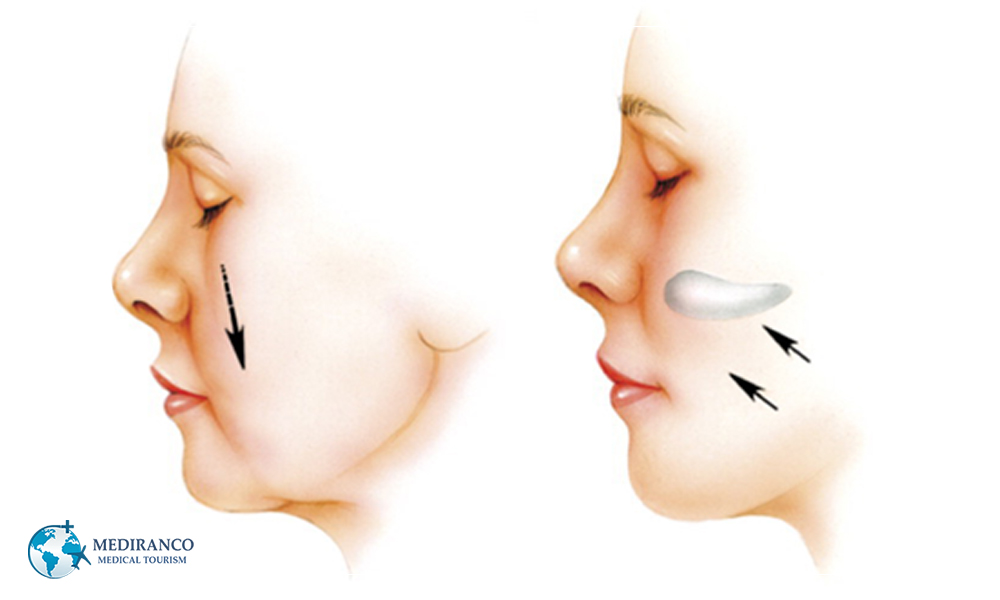Asymmetry is normally present and might be improved. Everyone has facial asymmetry, which is normal and expected. A cheek augmentation, also known as zygomatic augmentation or zygomatic implants, is a permanent procedure to create a more balanced, aesthetically pleasing shape to the face.
The goal of cheek augmentation is to add volume or lift to the cheeks.
Table of Contents
ToggleIn this article we will discuss:
- Introduction of zygomatic augmentation
- 5 Things to know before cheek augmentation
- How should I prepare for cheek augmentation?
- What are the steps of a cheek augmentation procedure?
- Are cheek implants better than fillers?
- How Do I Know Which procedure is Best for Me?
- What are risks of Cheek Augmentation?
Introduction of cheek augmentation
Plump cheeks and a well-defined chin not only create attractive facial proportions, but they also resonate with health, youth, and vitality. It’s also relatively easy to achieve these enhanced facial features through the use of dermal fillers and implants.
A cheek augmentation, , is a permanent procedure to create a more balanced, aesthetically pleasing shape to the face
The goal of cheek augmentation is to add volume or lift to the cheeks. Some people are bothered by their cheeks losing volume, or even sagging, with age. Others never develop the desired volume in their cheeks and are bothered by cheeks that may be considered flat or thin.
5 Things to know before cheek augmentation

1.How should I prepare for cheek augmentation?
In preparing for cheek augmentation, you may be asked to:
- Get lab testing or a medical evaluation
- Take certain medications or adjust your current medications
- Stop smoking
- Avoid taking aspirin, anti-inflammatory drugs and herbal supplements as they can increase bleeding
Cheek augmentation is typically performed in a hospital, licensed ambulatory surgery center or in-office procedure room, and will use either general anesthesia, intravenous sedation or local anesthesia. If your cheek augmentation is performed using general anesthesia or intravenous sedation, be sure to arrange for someone to drive you to and from surgery and to stay with you for at least the first night following surgery.

2.What are the steps of a cheek augmentation procedure?
A cheek augmentation procedure includes the following steps:
Step 1 – Anesthesia
Medications are administered for your comfort during the surgical procedure. The choices include local anesthesia, intravenous sedation and general anesthesia. Your doctor will recommend the best choice for you.
Step 2 – The incision
A cheek augmentation requires different incisions based on the technique used. If fat transfer is used to enhance your cheeks, you will likely have a small incision near the area of fat that is harvested and small incisions near your cheeks. These incisions usually measure just several millimeters in length. If solid cheek implants are used, then the incision is based on your surgeon’s preferred approach. Some plastic surgeons insert cheek implants through an incision inside the mouth, whereas other plastic surgeons perform the operation through an incision under your eyelid.
Step 3 – Closing the incisions
Sutures, skin adhesives or tapes close the skin incisions.
Step 4 – See the results
Your cheek augmentation will result in fuller and possibly softer-appearing cheeks. Some patients find that their cheeks can even appear lifted. The results of solid cheek implants are permanent, whereas the results from fat transfer may last several years.

3.Are cheek implants better than fillers?
While both cosmetic procedures can give you the aesthetic changes you desire, there are differences as to what both implants and fillers can offer, especially in terms of longevity.
Options for cheek augmentation
Valid surgical options for augmenting and enhancing the cheeks are fat grafting/transfer (where a patient’s own fat is used) or the use of solid cheek implants. A nonsurgical option is the use of injectable fillers to enhance the cheeks.

What Are Facial Implants?
Facial implants are typically made out of silicone or other solid materials that are compatible with human tissue and are designed to be permanent additions to the underlying facial structure. They are surgically placed to enhance or augment a particular physical structure on your face.
What Are dermal fillers?
The most commonly used dermal fillers come in the form of hyaluronic acid (HA), which is already naturally found in your skin. HA keeps the skin hydrated and plump. HA fillers such as Juvéderm® and Restylane® can replace lost volume while smoothing lines and wrinkles. Using dermal fillers can also help alter and improve facial shape and proportion, as well as provide definition and contours, achieving facial harmony. Using a very fine needle, these fillers are injected into areas that need enhancement, instantly restoring volume and contouring the face. Although temporary, they can provide natural-looking results without the need for surgery
Cheek implants are not better or worse than fillers, they’re just a different option and one that is dependent on the patient. Not all people are good candidates for cheek implants, and as with any procedure, there are pros and cons to each augmentation type. It comes down to the individual patient, their health, the condition of their skin, and their goals. Cheek implants require a more involved procedure than soft tissue filler and fat transfer, with more down time. However, this is a more permanent option and doesn’t require maintenance.

4.How Do I Know Which procedure is Best for Me?
Now that you know the key differences between these two types of procedures for facial augmentation, it should be easier to select the best option based on your goals, availability for downtime, and general health. Here’s a quick summary differentiating the best candidates for each procedure.
Good candidates for implants are:
- Those who want a more permanent solution for augmenting their facial structures
- Those who don’t want to repeat the procedure
- Those who are willing and ready to undergo surgery and its associated recovery time
- Those who are healthy enough to undergo surgery
Good candidates for fillers are:
- Those concerned about age-related volume loss
- Those who don’t want to undergo surgery and its associated downtime
- Those who want to restore lost volume in the cheeks rather than add more volume
- Those who are willing to undergo (or have the time) for touch-up treatments to maintain results
- Those who are not fit or have medical conditions that make them unsuitable for surgery

5.What are risks of Cheek Augmentation?
As with any cosmetic procedure, it is extremely personal to decide to undergo cheek augmentation surgery. It is important to be educated on the procedure in order to determine if the benefits help achieve your goals and if it is worth the possible risks and complications before you proceed with cheek augmentation.
The plastic surgeon will explain the risks and possible complications which are associated with cheek implant surgery. You need to sign consent forms to verify that you fully understand the procedures you have elected to undergo and agree to the associated risks and possible complications.
While they are not common, there are complications associated with cheek implants. There is an initial risk of having an adverse reaction to the anesthesia used for the cheek implant procedure. There is an association between anesthesia complications and the use of tobacco, antidepressants, and other substances. It is important to share a list of any substances you use with your surgeon prior to surgery.
Your surgeon will discuss all possible risks and complications with you prior to the procedure. It is important to share your medical history and any concerns with plastic surgeon. When necessary, the implants can be removed in about 10 minutes or adjusted in about 25 minutes.

Cheek augmentation in Iran
prominent cheeks are among those factors that can enhance facial beauty and are considered pleasing for many people. The relatively low cost of cheek implants in Iran and high-quality cheek augmentation procedure at modern clinics in the country make them an especially attractive cosmetic solution. for more information and reservations consultants you can contact Mediranco health tourism company
Conclusion
Cheek augmentation is a kind of aesthetic operation to add or increase volume to the cheeks or lift them. Along with aging, our cheeks start sagging and losing volume. Cheek augmentation can be a good choice to remedy this process. Cheek augmentation can restore your youthful appearance and bring harmony and balance to your facial features. This surgery can also helpful for the people who have suffered from traumas in their mid-facial zones besides it can be beneficial for younger people with narrow or asymmetrical facial features. In this regard, cheek augmentation can also be considered as reconstructive operation besides cosmetic one.


